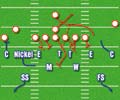Article CategoriesAFM Magazine
|
Building the FoundationChicago\'s Cover 2by: Vance Bedford Defensive Backs coach, Chicago Bears © More from this issue The past decade has seen NFL offenses evolve evolve the past decade by using multiple substitutions and formations to create mismatches in the run and pass game. Therefore, it is more important than ever to properly plan for an opponant and develop a sound base package to build a foundation to stop either the run or pass. The No. 1 goal of a defense must still be to stop the run. With multiple formations the offense can spread a defense out and make it tough to stop the run. Defenses are forced to defend 7 gaps with 6 players. If the offense forces the defense to substitute to defend three wide receiver sets on runs downs, the defense is forced to play soft with a pass defense on a run down (See Diagram 1). |
|
|||||||
| HOME |
MAGAZINE |
SUBSCRIBE | ONLINE COLUMNISTS | COACHING VIDEOS |
Copyright 2025, AmericanFootballMonthly.com
All Rights Reserved






